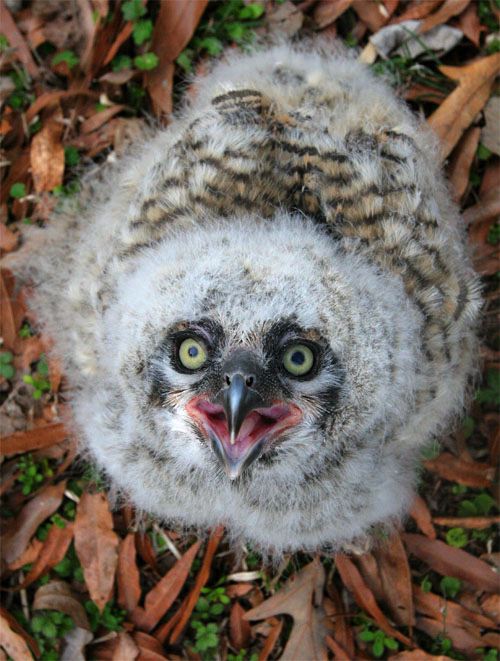
Great Horned Owl nestling, Bubo virginianus.
Photo copyright by Bill Hilton Jr.
Contact Bill to purchase this and other photos, the sales of which support the
wonderful work done by Hilton Pond Center.
The chimney swifts are coming! Have you seen them yet? If so, Chimneyswifts.org would like to hear from you! This is an organization that promotes the conservation of Chimney Swifts, Chaetura pelagica (pictured), through public education, preservation of existing habitat and creation of new nesting and roosting sites. It appears that they have been doing the project for several years now.
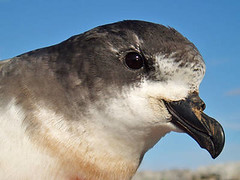 Four Cahows, or Bermuda Petrels, Pterodroma cahow (pictured), banded as fledglings in May 2002, returned to their nesting islets off Bermuda in February 2006. Over the last five years, an ambitous recovery program involving relocation and construction of artificial burrows on "hurricane-proof" islets has helped raise Cahow numbers to around 250.
Four Cahows, or Bermuda Petrels, Pterodroma cahow (pictured), banded as fledglings in May 2002, returned to their nesting islets off Bermuda in February 2006. Over the last five years, an ambitous recovery program involving relocation and construction of artificial burrows on "hurricane-proof" islets has helped raise Cahow numbers to around 250.
In 1938, a new species of passerine was collected in the dry forest habitat at Juruena, Central Brazil. In appearance, the new species was mostly black except for a small white throat patch and white belly. This stout and conical bill gave it its English name, Cone-billed Tanager, Conothraupis mesoleuca, but remarkably it was another 66 years before the species was seen anywhere again. But late in 2004, a Brazilian ornithologist rediscovered it and remarkably, it has been seen and even videotaped since then. Brazil is home to more globally threatened birds than any other country on earth.
People Hurting Birds
In typical knee-jerk fashion, the misnamed "Wildlife Services" unit of the USDA are using our tax dollars to poison thousands of crows in Lancaster, PA. Why? Because they want them to move their night time roost. I guess they have never heard of using deterrent methods and other forms of persuasion to accomplish their goals. GrrlScientist wonders; why are so many people in power so eager to destroy anything that causes them problems, rather than using their heads to think of a humane solution?
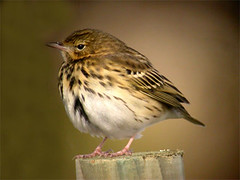 Many bird species, including both long-distance migrants as well as sedentary birds in the UK have suffered a population decrease, reveals the most extensive survey taken in 20 years. It shows a 70 per cent decline in birds such as the tree pipit, Anthus trivialis (pictured), and spotted flycatcher, Muscicapa striata, in some areas. Biodiversity Minister Jim Knight released these figures and said they highlight the winners and losers in the bird population in the UK's changing landscape and climate. "It not only tells us about the species themselves, but is a useful indicator of wider biodiversity issues within our countryside, that are impacting on our birds, " said Knight.
Many bird species, including both long-distance migrants as well as sedentary birds in the UK have suffered a population decrease, reveals the most extensive survey taken in 20 years. It shows a 70 per cent decline in birds such as the tree pipit, Anthus trivialis (pictured), and spotted flycatcher, Muscicapa striata, in some areas. Biodiversity Minister Jim Knight released these figures and said they highlight the winners and losers in the bird population in the UK's changing landscape and climate. "It not only tells us about the species themselves, but is a useful indicator of wider biodiversity issues within our countryside, that are impacting on our birds, " said Knight.
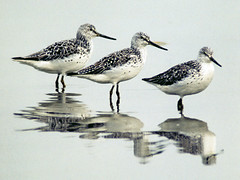 The South Korean Supreme Court has ruled to allow the government to continue building a seawall that will permanently close off 40,000 hectares of bird-rich tidal flats and shallows from the sea. Two of the thirteen Supreme Court judges declared that the Saemangeum reclamation project was based on a seriously flawed Environmental Impact Survey, and that it has costs that will be borne by future generations. However, the Supreme Court as a body fell short of demanding the project be cancelled. The impacts on migratory shorebirds are expected to be enormous and long term. The site is famous as a migratory refueling site for concentrations of globally threatened species such as Spoon-billed Sandpiper, Eurynorhynchus pygmeus, and Spotted Greenshank, Tringa guttifer (pictured). It also is thought to host up to 30% of the world's migrating Great Knots, Calidris tenuirostris, an extreme long-distance migrant.
The South Korean Supreme Court has ruled to allow the government to continue building a seawall that will permanently close off 40,000 hectares of bird-rich tidal flats and shallows from the sea. Two of the thirteen Supreme Court judges declared that the Saemangeum reclamation project was based on a seriously flawed Environmental Impact Survey, and that it has costs that will be borne by future generations. However, the Supreme Court as a body fell short of demanding the project be cancelled. The impacts on migratory shorebirds are expected to be enormous and long term. The site is famous as a migratory refueling site for concentrations of globally threatened species such as Spoon-billed Sandpiper, Eurynorhynchus pygmeus, and Spotted Greenshank, Tringa guttifer (pictured). It also is thought to host up to 30% of the world's migrating Great Knots, Calidris tenuirostris, an extreme long-distance migrant.
 The Global Biodiversity Outlook (GBO) was published as national delegates gather in Brazil under the UN Convention on Biological Diversity. The GBO says "unprecedented efforts" will be needed to slow the decline in the richness of living systems by 2010. According to this analysis, the biosphere takes nearly 15 months to renew what humanity exploits in one year. The report also showed that the abundance and variety of species continue to decrease across the planet, according to an index measuring the percentage of species with good prospects for survival; in fact, bird variety is on the decline in every ecosystem type from the oceans to the forests. Sadly, unless the GBO can convince their colleagues in government who oversee agriculture, energy, world trade and industry that losing biodiversity threatens people and economies across the planet, the decisions and pledges made will do little to reverse the trends identified in this report.
The Global Biodiversity Outlook (GBO) was published as national delegates gather in Brazil under the UN Convention on Biological Diversity. The GBO says "unprecedented efforts" will be needed to slow the decline in the richness of living systems by 2010. According to this analysis, the biosphere takes nearly 15 months to renew what humanity exploits in one year. The report also showed that the abundance and variety of species continue to decrease across the planet, according to an index measuring the percentage of species with good prospects for survival; in fact, bird variety is on the decline in every ecosystem type from the oceans to the forests. Sadly, unless the GBO can convince their colleagues in government who oversee agriculture, energy, world trade and industry that losing biodiversity threatens people and economies across the planet, the decisions and pledges made will do little to reverse the trends identified in this report.
Ivory-billed Woodpecker News
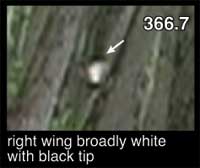 Those who live and work in the region where an ivory-billed woodpecker, Campephilus principalis (pictured, a still shot from the disputed video), was reportedly spotted are used to people doubting the bird's discovery - they've heard it before. "We've been hearing people say they don't believe it's here since the beginning," said Sandra Kemmer, executive director of the Chamber of Commerce in Brinkley, located about halfway between Little Rock and Memphis, Tennessee. "I'm actually glad because it keeps it in the eye of the public." Governor Mike Huckabee said the Science article illustrates the authors' poor bird-watching ability more than it proves that the ivory-billed woodpecker doesn't live in Arkansas. National Public Radio's Morning Edition also features a streaming story. You can access the Science articles for Sibley et al's challenge and Fitzpatrick et al's response. GrrlScientist note: Okay mister Arkansas state governor, so you claim that the authors have poor birding skills, but does that mean that the other experts also have poor birding skills, since they also cannot find it?
Those who live and work in the region where an ivory-billed woodpecker, Campephilus principalis (pictured, a still shot from the disputed video), was reportedly spotted are used to people doubting the bird's discovery - they've heard it before. "We've been hearing people say they don't believe it's here since the beginning," said Sandra Kemmer, executive director of the Chamber of Commerce in Brinkley, located about halfway between Little Rock and Memphis, Tennessee. "I'm actually glad because it keeps it in the eye of the public." Governor Mike Huckabee said the Science article illustrates the authors' poor bird-watching ability more than it proves that the ivory-billed woodpecker doesn't live in Arkansas. National Public Radio's Morning Edition also features a streaming story. You can access the Science articles for Sibley et al's challenge and Fitzpatrick et al's response. GrrlScientist note: Okay mister Arkansas state governor, so you claim that the authors have poor birding skills, but does that mean that the other experts also have poor birding skills, since they also cannot find it?
Avian Zoonosis News
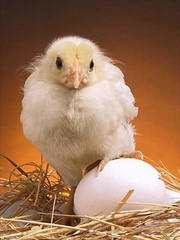 This past week alone, both the United Nations and the Office of Homeland Security implicated migratory birds as the most likely carriers of H5N1 to American shores, while cable news scrambled to get bird migration maps. Migratory fowl could possibly bring H5N1 here while they travel. But there is an equal, if not greater, chance that H5N1 will fly to North America on an airplane transporting poultry, legally or otherwise. For example, a shipment of chicken feet, marked "jellyfish", was recently smuggled into the United States from Thailand, arriving in Connecticut. This is not to say that the virus can't be carried by, and kill, wild birds, because it can. Yet the spread of H5N1 from the activities of wild birds pales in comparison to the poultry trade. GrrlScientist note: Finally, more people are starting to tell the facts to the public regarding how this virus is primarily spread, instead of mindlessly repeating the same old lies, which is causing widespread panic. Further, new data show that a pandemic of bird flu is not imminent, as so widely claimed.
This past week alone, both the United Nations and the Office of Homeland Security implicated migratory birds as the most likely carriers of H5N1 to American shores, while cable news scrambled to get bird migration maps. Migratory fowl could possibly bring H5N1 here while they travel. But there is an equal, if not greater, chance that H5N1 will fly to North America on an airplane transporting poultry, legally or otherwise. For example, a shipment of chicken feet, marked "jellyfish", was recently smuggled into the United States from Thailand, arriving in Connecticut. This is not to say that the virus can't be carried by, and kill, wild birds, because it can. Yet the spread of H5N1 from the activities of wild birds pales in comparison to the poultry trade. GrrlScientist note: Finally, more people are starting to tell the facts to the public regarding how this virus is primarily spread, instead of mindlessly repeating the same old lies, which is causing widespread panic. Further, new data show that a pandemic of bird flu is not imminent, as so widely claimed.
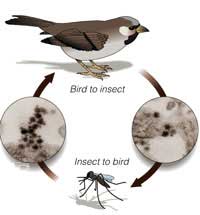 Since its introduction to the United States in 1999, West Nile virus has become the major vector-borne disease in the US, with 770 reported deaths, 20,000 reported illnesses, and approximately one million people infected. The virus is transmitted by Culex pipiens mosquitoes (the "vector") and cycles between birds that the mosquitoes feed on (pictured). Humans can also be infected with the virus when bitten by these mosquitoes. In a new study published in the open access journal, PLoS Biology, Marm Kilpatrick, Peter Daszak, and colleagues present evidence that the major vector of West Nile virus in the USA, Culex mosquitoes, change their feeding behavior in the fall from their preferred host, American robins, Turdus migratorius, to humans, Homo sapiens, resulting in large scale outbreaks of disease.
Since its introduction to the United States in 1999, West Nile virus has become the major vector-borne disease in the US, with 770 reported deaths, 20,000 reported illnesses, and approximately one million people infected. The virus is transmitted by Culex pipiens mosquitoes (the "vector") and cycles between birds that the mosquitoes feed on (pictured). Humans can also be infected with the virus when bitten by these mosquitoes. In a new study published in the open access journal, PLoS Biology, Marm Kilpatrick, Peter Daszak, and colleagues present evidence that the major vector of West Nile virus in the USA, Culex mosquitoes, change their feeding behavior in the fall from their preferred host, American robins, Turdus migratorius, to humans, Homo sapiens, resulting in large scale outbreaks of disease.
Bird Cams
XCel Energy has installed bird cams that monitor raptors from a variety of species. The link leads you to a fact filled index page that includes links to a bald eagle cam, a great horned owl cam, a peregrine falcon cam and possibly, in the near future, osprey and kestrel cams, all linked from the left sideboard.
Streaming Birds
 This week on BirdNote, you will learn more about; Monday, why a hummingbird's gorget glitters; Tuesday, the mechanics of diving brown pelicans, Pelecanus occidentalis; Wednesday, Harry Potter's owls ( can hardly wait for this one!); Thursday, the drumming of the Norther Flicker, Colaptes auratus; and Friday, who was Douglas -- David Douglas, the naturalist? BirdNotes transport the listener out of the daily grind with two-minute vignettes that incorporate the rich sounds of birds provided by Cornell University and by other sound recordists, with photographs and written stories that illustrate the interesting -- and in some cases, truly amazing -- abilities of birds. Some of the shows are Pacific Northwest-oriented, but many are of general interest. BirdNote can be heard live, Monday through Friday, 8:58-9:00AM in Western Washington state and Southern British Columbia, Canada, on KPLU radio and now also in North Central Washington state on KOHO radio. All episodes are available in the BirdNote archives, both in written transcript and mp3 formats, along with photographs. Listener ideas and comments are welcomed. [rss mp3/podcast].
This week on BirdNote, you will learn more about; Monday, why a hummingbird's gorget glitters; Tuesday, the mechanics of diving brown pelicans, Pelecanus occidentalis; Wednesday, Harry Potter's owls ( can hardly wait for this one!); Thursday, the drumming of the Norther Flicker, Colaptes auratus; and Friday, who was Douglas -- David Douglas, the naturalist? BirdNotes transport the listener out of the daily grind with two-minute vignettes that incorporate the rich sounds of birds provided by Cornell University and by other sound recordists, with photographs and written stories that illustrate the interesting -- and in some cases, truly amazing -- abilities of birds. Some of the shows are Pacific Northwest-oriented, but many are of general interest. BirdNote can be heard live, Monday through Friday, 8:58-9:00AM in Western Washington state and Southern British Columbia, Canada, on KPLU radio and now also in North Central Washington state on KOHO radio. All episodes are available in the BirdNote archives, both in written transcript and mp3 formats, along with photographs. Listener ideas and comments are welcomed. [rss mp3/podcast].
Miscellaneous Birds
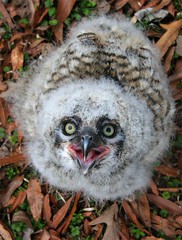 At This Week at Hilton Pond, their facility was home for a few hours to an orphaned Great Horned Owl, Bubo virginianus (pictured, top), which is now growing up at the Carolina Raptor Center. This edition includes a photo essay about this fluffy little bird -- including how it was found and how it looked and acted. As always, they also include a tally of birds banded during the period, plus several miscellaneous natural history notes. Also note that all photographs on the site are for sale, and all proceeds support their work. Please try again later if the page loads slowly; it's probably because lots of people are on-line watching the NCAA basketball tournament. March madness, indeed!
At This Week at Hilton Pond, their facility was home for a few hours to an orphaned Great Horned Owl, Bubo virginianus (pictured, top), which is now growing up at the Carolina Raptor Center. This edition includes a photo essay about this fluffy little bird -- including how it was found and how it looked and acted. As always, they also include a tally of birds banded during the period, plus several miscellaneous natural history notes. Also note that all photographs on the site are for sale, and all proceeds support their work. Please try again later if the page loads slowly; it's probably because lots of people are on-line watching the NCAA basketball tournament. March madness, indeed!
 A remarkable collection of wacky sound imitations made by wild birds, Bird Mimicry, is now available on CD. This CD includes such unlikely sounds as a jay that neighs like a horse and a blackbird that imitates a computer modem. This CD features some of the rarest recordings ever captured and was compiled from the world's largest collection of nature sounds held at the British Library.
A remarkable collection of wacky sound imitations made by wild birds, Bird Mimicry, is now available on CD. This CD includes such unlikely sounds as a jay that neighs like a horse and a blackbird that imitates a computer modem. This CD features some of the rarest recordings ever captured and was compiled from the world's largest collection of nature sounds held at the British Library.
While I am on the toppic of birdsong recordings, the StarTribune has some recordings of birdsongs accessible by telephone (Dial-a-Birdsong?). I called them last night and listened to all their recordings. In addition to the numbers listed in the linked article, you can enter these, listed along with their species; 1608 house wren; 1609 marsh wren; 1610 sedge wren; and 1611 common raven.
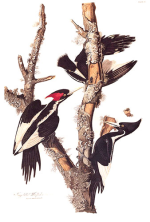 The rare ivory-billed woodpecker was recently spotted in Manhattan! The New York Historical Society is showing John James Audubon's 180 year old watercolor of these showy woodpeckers as part of its multimedia "Audubon's Aviary" exhibit, which opened on 17 March. Along with 40 of Audubon's watercolors -- so delicate, they can only be exposed to sunlight once every 10 years -- the exhibit attempts to recreate Audubon's obsession with nature through an innovative soundscape that includes bird calls provided by Cornell University's ornithological lab. The sophisticated system of sensors and speakers makes it sound as if some of the birds are emerging from the watercolors and taking flight overhead. GrrlScientist note: This is a treat for anyone who loves birds, or who loves art. I've attended the last 3 shows, several times each, and plan to visit this one, too.
The rare ivory-billed woodpecker was recently spotted in Manhattan! The New York Historical Society is showing John James Audubon's 180 year old watercolor of these showy woodpeckers as part of its multimedia "Audubon's Aviary" exhibit, which opened on 17 March. Along with 40 of Audubon's watercolors -- so delicate, they can only be exposed to sunlight once every 10 years -- the exhibit attempts to recreate Audubon's obsession with nature through an innovative soundscape that includes bird calls provided by Cornell University's ornithological lab. The sophisticated system of sensors and speakers makes it sound as if some of the birds are emerging from the watercolors and taking flight overhead. GrrlScientist note: This is a treat for anyone who loves birds, or who loves art. I've attended the last 3 shows, several times each, and plan to visit this one, too.
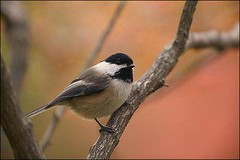 Michigan's normally genteel community of birdwatchers is all atwitter these days. The source of the consternation: Should the American robin, Turdus migratorius, be knocked from its perch as the state bird? Angry birders are describing the robin and its challengers, Kirtland's warbler, Dendroica kirtlandii, and black-capped chickadee, Poecile atricapillus, as aloof, common, ill-tempered, unfaithful. And they've taken the fight to the Michigan Legislature, where no fewer than three bills are pending on the matter.
Michigan's normally genteel community of birdwatchers is all atwitter these days. The source of the consternation: Should the American robin, Turdus migratorius, be knocked from its perch as the state bird? Angry birders are describing the robin and its challengers, Kirtland's warbler, Dendroica kirtlandii, and black-capped chickadee, Poecile atricapillus, as aloof, common, ill-tempered, unfaithful. And they've taken the fight to the Michigan Legislature, where no fewer than three bills are pending on the matter.
The Fine Print: Thanks to my bird pals; Caren, Ian, Carl, Phil, Bill, Sara, Diane, Charles, John, Ellen and Ron for some of the news story links that you are enjoying here. All photographs that appear here are either linked from the news stories that they accompany or they are linked to the site where they are found. You can follow these links by clicking on individual images.
I also appreciate long-time readers, Jamie, Tony and anonymous blog reader, for nominating Birds in the News for a 2005 Koufax Award for Best Series! Voting for the first round was rumored to be complete, so I am waiting to learn whether Birds in the News made it to the finalists' round of voting when the champion is identified.
Previous : : Birds in the News : : Next
tags: Birds in the News, ornithology, birds, avian, newsletter


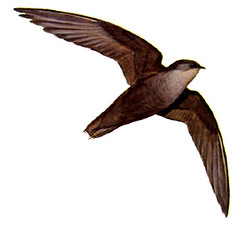
About the Arkansas state governor, come on, for once a politician is interested in having something alive. If he insults the birding skills of a few people it is still an improvement.
When I was living in Houston,TX 20 years ago I remember reading an article out of Austin about the building of bat houses for bat conservation. As an aside it was mentioned that other organizations were starting to think about building chimney swift towers - from the map available on one of the linked chimney swift sites the idea has appeared to have taken off (no pun intended).
I don't remember specifically seeing any chimney swifts in central Texas but I do remember the white-throated swifts soaring near the South Rim of the Chisos Mts. in Big Bend National Park - spectacular birds.
The final round of voting for Koufax Awards is already open at Wampum, and closes on Sunday.
Oh, thanks for pointing out the Xcel bird cams... they're too cool. The owl and the eagle are both my neighbors, although the owl only lives a few miles away. At first, when I loaded the cam, I tried to discern the odd shapes, rather confused. When I refreshed, suddenly there was the behind of a great horned owl. I've seen them before, during a rare dusk, atop a sign or lamppost... it is something else to see one up close, from my desk. I feel as if I've made a new feathered friend--who eats rodents. :)
And, I just discovered, there's even baby owls! (Sorry for the double comment, but, they're babies!)
well, you do have a point, Caio de gaia. but we all know the governor's motivation, and it has nothing whatsoever to do with the love of the birds themselves.
Matt; i am glad to see this idea has taken off, too. the world needs more swifts. did you click on the picture that accompanies the story? i linked to a great site about chimney swifts from that picture that includes a sound file of the birds.
thanks for mentioning that John. i was disappointed to see that Birds in the News (along with all the other nominations for Scientific Life) didn't make it into the finalist round.
Karmen; and just think; those owlets look just like the one at the top of this page!
Since this is mainly about domesticated birds it is not eligible for I And The Bird, but I thought you'd be interested and I'd be interested in your thoughts...
I believe in the re-discovery of the Ivory Billed Woodpecker. I have also kept current at Fishcrow.com because this individual has perservered and seen 2 IBWs twice. I have applied for an internship at the Whiteriver WLR but am interested in any position (pay is not a factor) where birds and birding are involved. I have a BA and would like to get my Masters in orinthology. Any ideas? Cara
http://www.birds.cornell.edu/birdhouse/nestboxcam/
I don't know if you have already mentioned this site (I may have missed it) but it's definitely worth a look!